Canadian History With New Eyes: The Dark Ages?
The Dark Ages & the French Wars of Religion Some time ago, I started to
Home / Samuel de Champlain -The Huguenot Years (1)
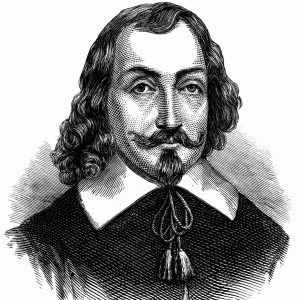
Champlain was born into a family of mariners in 1574, in the French province of Aunis in Brouage, near the port city of La Rochelle, in the Protestant province of Saintonge. Both his father and his uncle were sailors and navigators. His father was also a captain in the navy, as reflected in Samuel’s marriage contract.
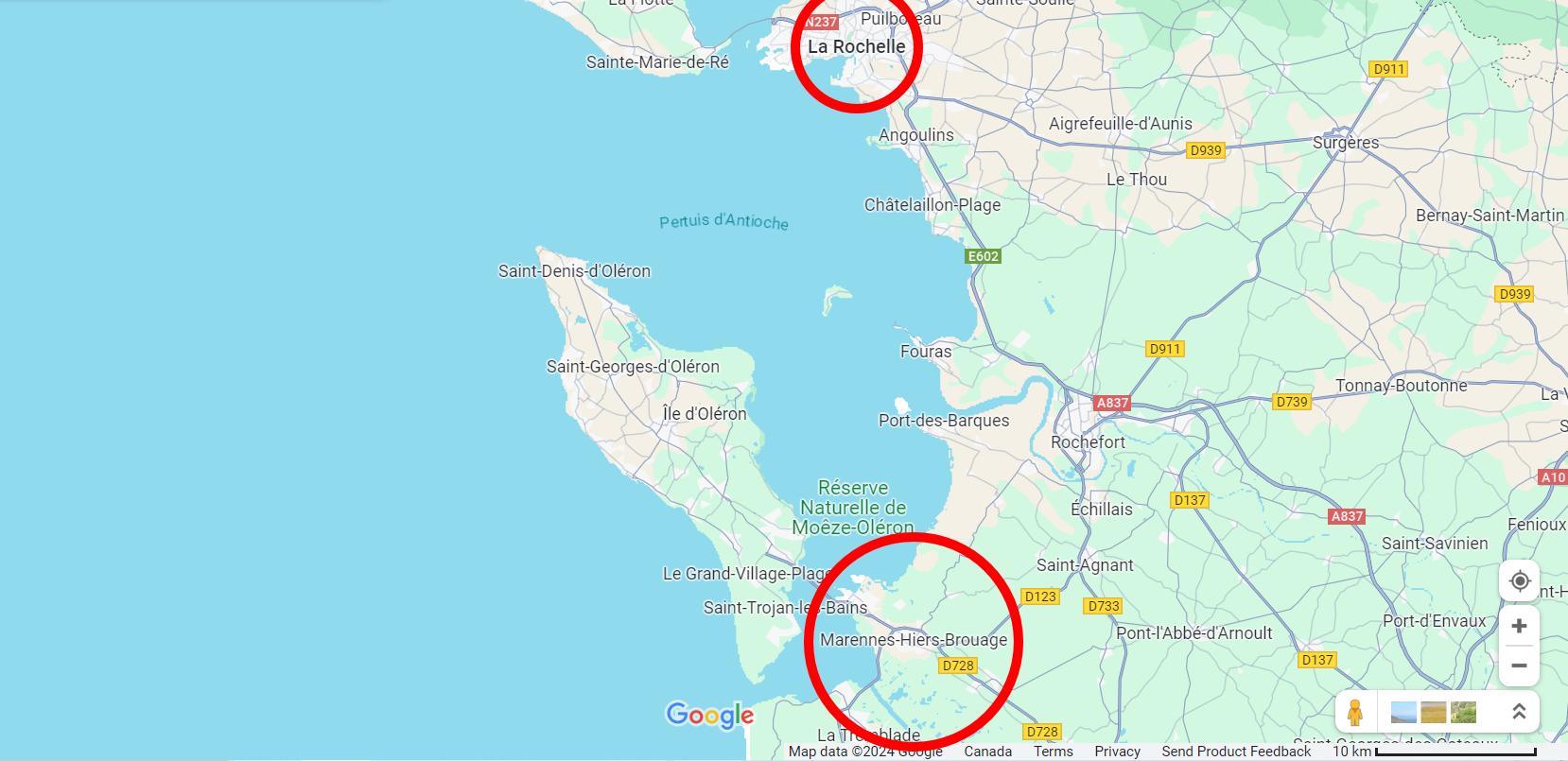
He was married to Helene Boulle, daughter of Nicholas Boulle, the king’s chamberlain. His marriage contract indicated that he was the son of Anthoine de Champlain, captain in the navy, and Dame Margueritte Le Roy. This indicates that the family had social standing in the community.
Because of his environment, he learnt the skills of the trade – navigation, drawing, making nautical charts, and writing reports. He was a cartographer, a soldier, a navigator, explorer, colonizer, administrator and author.
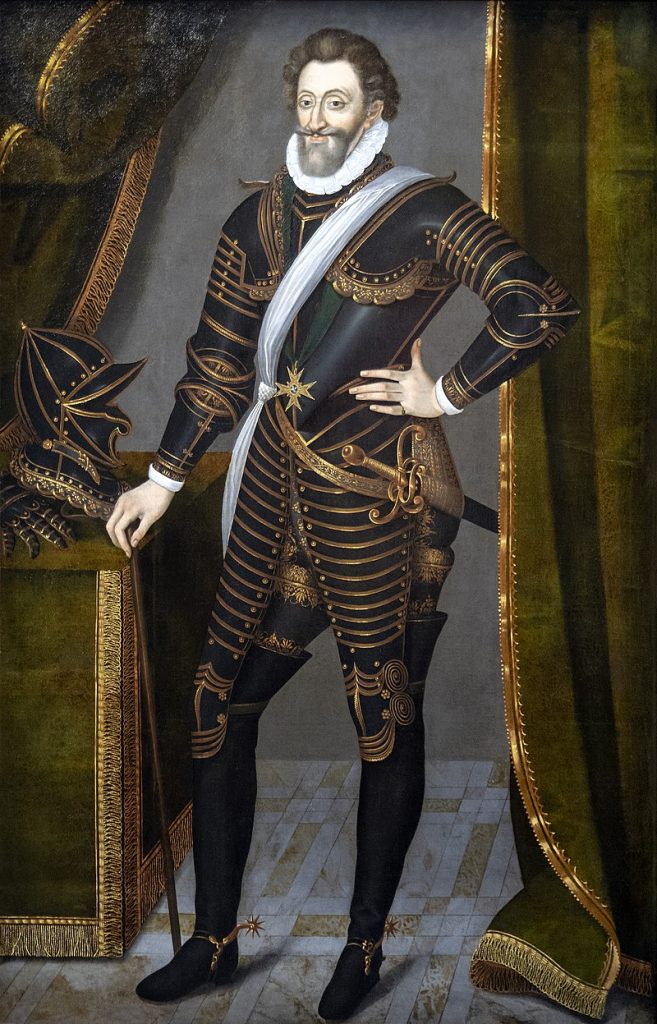 He served in King Henry lV’s army in Brittany in the Wars of against the Catholic League, during the period of 1589 to 1598. He started at the rank of quartermaster at the age of 19, feeding and caring for the horses. He also learnt to use firearms which he would later use to build relationships with the Algonquin, Huron and Wendat Natives against their enemies – the Iroquois.
He served in King Henry lV’s army in Brittany in the Wars of against the Catholic League, during the period of 1589 to 1598. He started at the rank of quartermaster at the age of 19, feeding and caring for the horses. He also learnt to use firearms which he would later use to build relationships with the Algonquin, Huron and Wendat Natives against their enemies – the Iroquois.
In 1593, even though Henry IV had officially converted to Catholicism to bring peace to France, there were still some pockets of resistance by the Spanish army who did not want to give up the ports they had won in France.
Champlain joined an army of 800 men led by the Governor of Brouage and Santoinge to fight one of those pockets of resistance by the Spanish army in Brittany. He served under the supplies officer Jean Hardy as his assistant, with responsibilities for billeting the troops. In 1595, he was paid handsomely and by 1597, he was captain of the company.
His experience in cartography and strategic planning got quite the boost while he was stationed in Brittany. There, he mingled with French dignitaries and a contingent of English soldiers sent by Elizabeth I to support Henry IV in his war against the Catholic League and Spain. Among the English was a cartographer, Ralph Treswell, who was responsible for producing a map of Brittany for military and strategic planning. As quartermaster, Champlain also had the opportunity to produce maps for billeting and moving the troops.
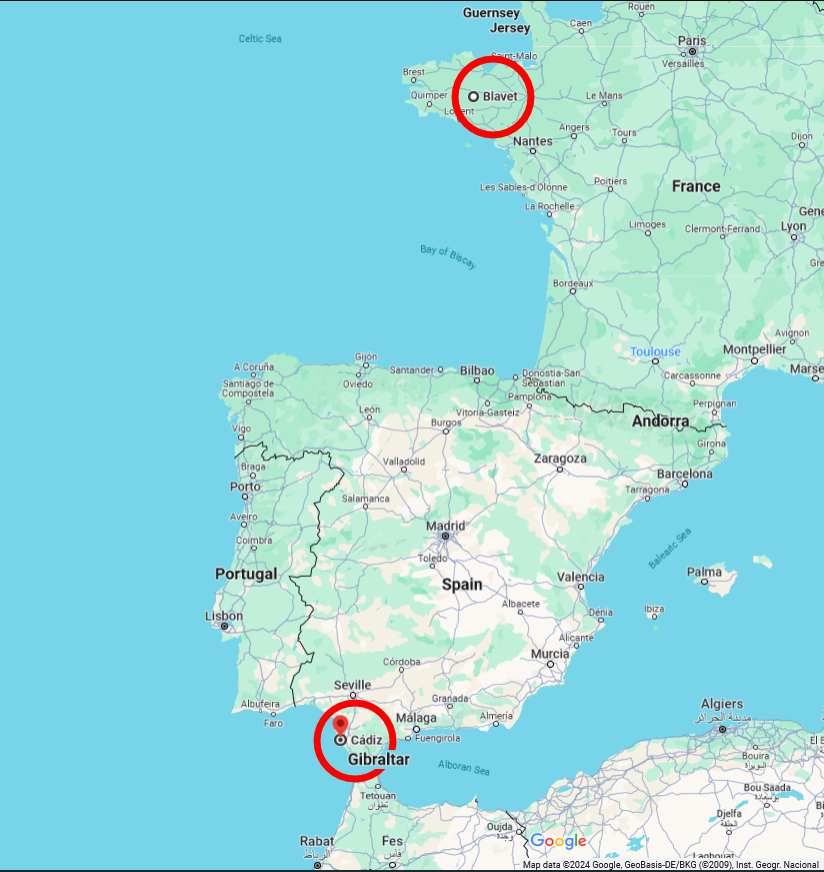 After a Peace Treaty was signed between France and Spain in May 1598, Prince Phillip II of Spain then chartered some ships to move the Spanish troops from Blavet in Brittany to Cadiz in Spain. Champlain’s uncle was contracted to use his ship, the Saint-Julien, to move some troops. Champlain was invited to accompany him to Cadiz.
After a Peace Treaty was signed between France and Spain in May 1598, Prince Phillip II of Spain then chartered some ships to move the Spanish troops from Blavet in Brittany to Cadiz in Spain. Champlain’s uncle was contracted to use his ship, the Saint-Julien, to move some troops. Champlain was invited to accompany him to Cadiz.
After some respite in Cadiz, the ship was again chartered by Spain, this time to accompany another Spanish fleet (a larger one) to the West Indies. He was again invited on the voyage which lasted 3 years.
When his uncle gave command of the ship to the Spanish captain, he said to Champlain ‘watch over the ship’. Champlain took the instruction seriously enough that he kept detailed notes about Spanish holdings, complete with illustrations, on a journey that took him from the Caribbean to Mexico city.
His uncle became ill in 1600 and asked Samuel to handle his business affairs. When he died in 1601, Champlain inherited all of his estate which included a merchant ship, commercial properties in Spain, and an estate near the Huguenot city of La Rochelle.
On his return to Brouage to settle his uncle’s estate, he met with his military friend, Rene Rory de Potonville, who was instrumental in getting this secret report to Admiral Aymar de Chaste, who delivered it to King Henry lV. Champlain was rewarded by the king with an annual pension and an invitation to the Court. This report was published for the first time in 1870, and it was named, ‘Narrative of a Voyage to the West Indies and Mexico 1599-1602′.
By 1603, he was commissioned by Henry IV, to accompany Admiral Aymar de Chaste, the first recipient of a fur trading monopoly, to New France. He would be the King’s trustworthy observer to bring back an accurate report like he did on the trip to the West Indies.
In 1603, Champlain left on his first expedition to New France in the company of Aymar de Chaste (fur trade monopoly holder), Pierre Chauvin de Tonnetuit (Lieutenant General of New France ) and St Malo merchant Francois Grave du Pont (owner of the – the Bonne Renommee). Francois Grave had been trading furs along the St Lawrence River for 20 years and had many dealings with the Innu (Montagnais). Two other ships accompanied them, one of which was owned by another Saint-Malo merchant.
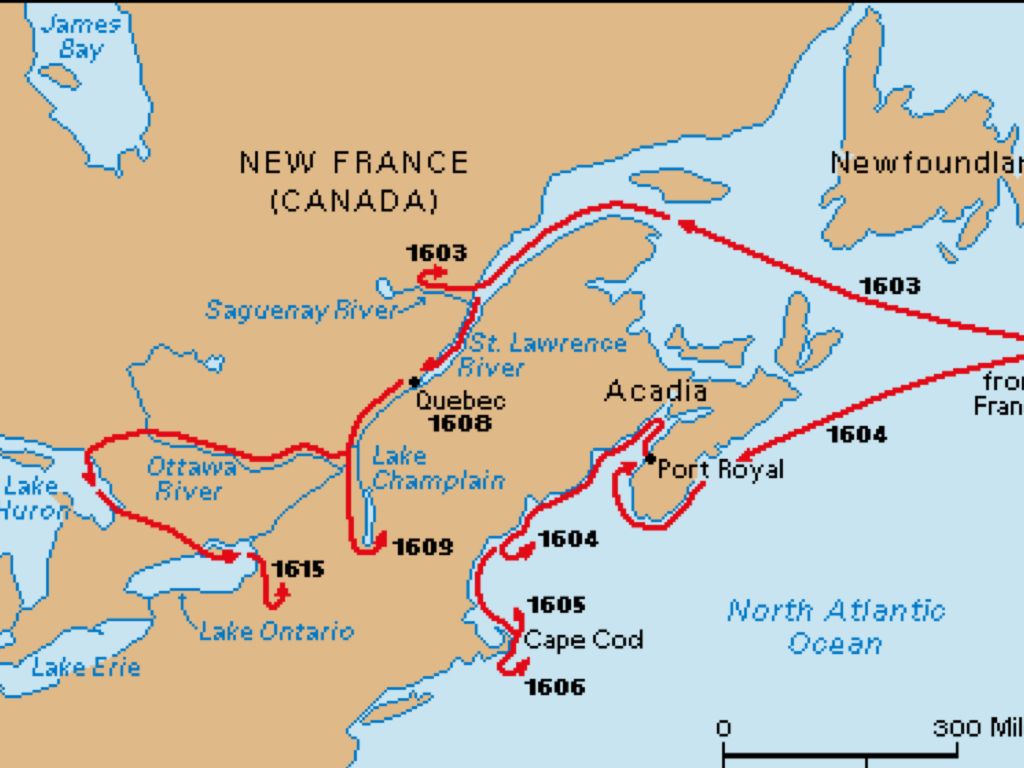 Champlain created a map of the St Lawrence River, publishing an account of his trip entitled, ‘Concerning the Savages: or Travels of Samuel Champlain of Brouages, made in New France in the year 1603’.
Champlain created a map of the St Lawrence River, publishing an account of his trip entitled, ‘Concerning the Savages: or Travels of Samuel Champlain of Brouages, made in New France in the year 1603’.
In this account, he chronicled the good relationships that had been established between the French (Francois Grave du Pont and Pierre Chauvin de Tonnetuit) and the Montagnais Indians of Tadoussac and some of their Algonquin allies (Hurons and Etchemins).
Champlain recorded that at this first meeting, over 1000 Natives had gathered post-war, to celebrate their victory over the Mohawks. They had 100 heads on display to prove their victory. At the same time, two Innu, who had spent a year in France as guests of Pierre Chauvin de Tonnetuit and King Henry IV, returned to Tadoussac.
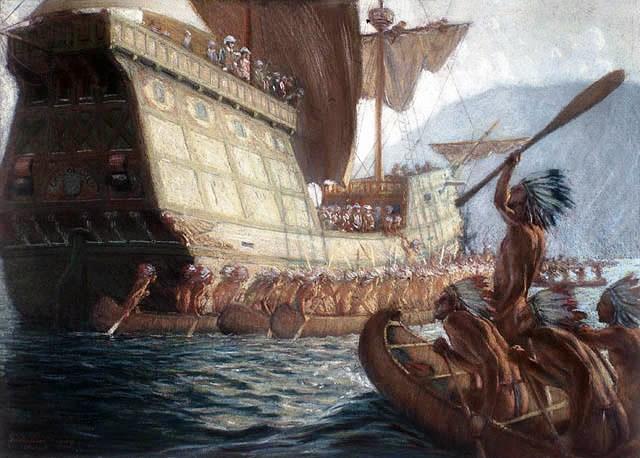 One of them gave a glowing report of their time in France and the hopes expressed by King Henry IV for cooperation, colonization and even intermarriage.
One of them gave a glowing report of their time in France and the hopes expressed by King Henry IV for cooperation, colonization and even intermarriage.
He described “the warm welcome given them by the King, and the good treatment they had received in France, and that they had assured themselves that His said Majesty wished them well, and wished to populate their land, and to make peace with their enemies (who are the Iroquois) or send them forces to conquer them.ˮ
In turn, (Chief) Anadabijou gave a lengthy address, saying “that he was very glad that His said Majesty would populate their land, and make war on their enemies, that there was no nation in the world to whom they wished better than the French: He ended by telling them all of the good and useful things they would receive from His said Majesty.ˮ (biographi.ca)
Days later, Champlain and Francois Grave, with interpreters and guides, explored the Saguenay and the St. Lawrence Rivers. Champlain made careful notes about the geography, vegetation and suitability for settlements. He also developed a map of the area, all of which he gave to Henry IV.
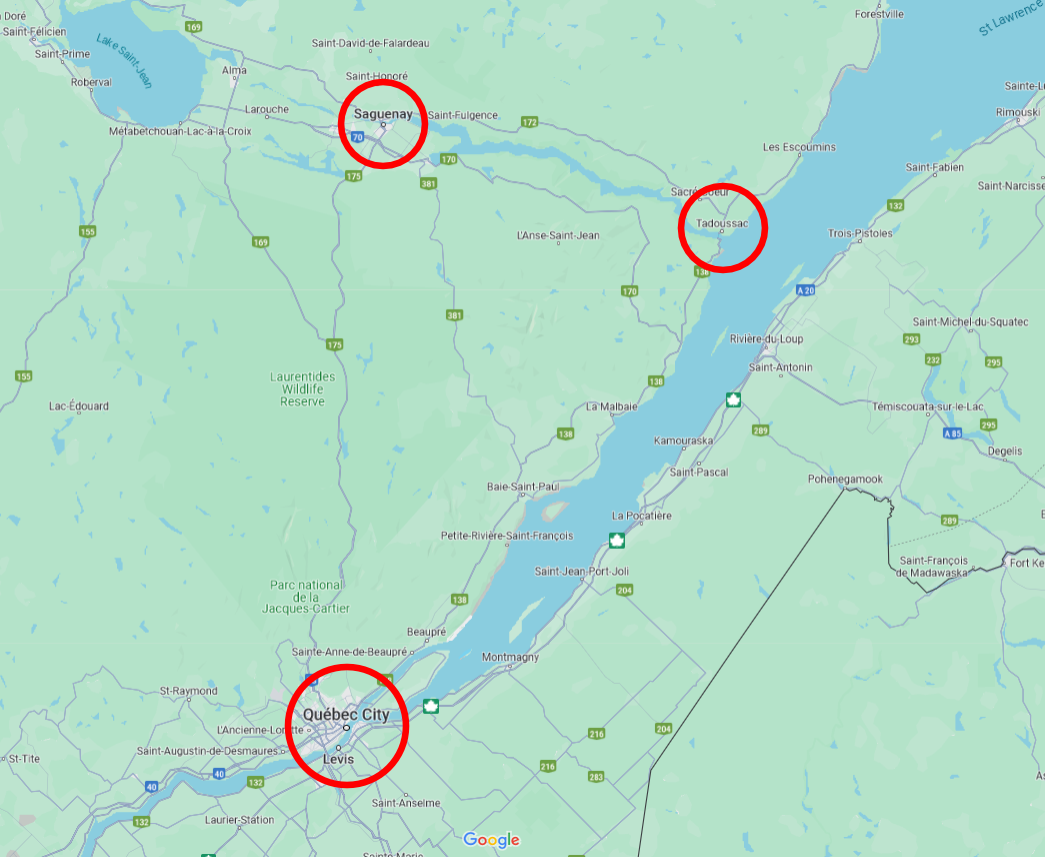
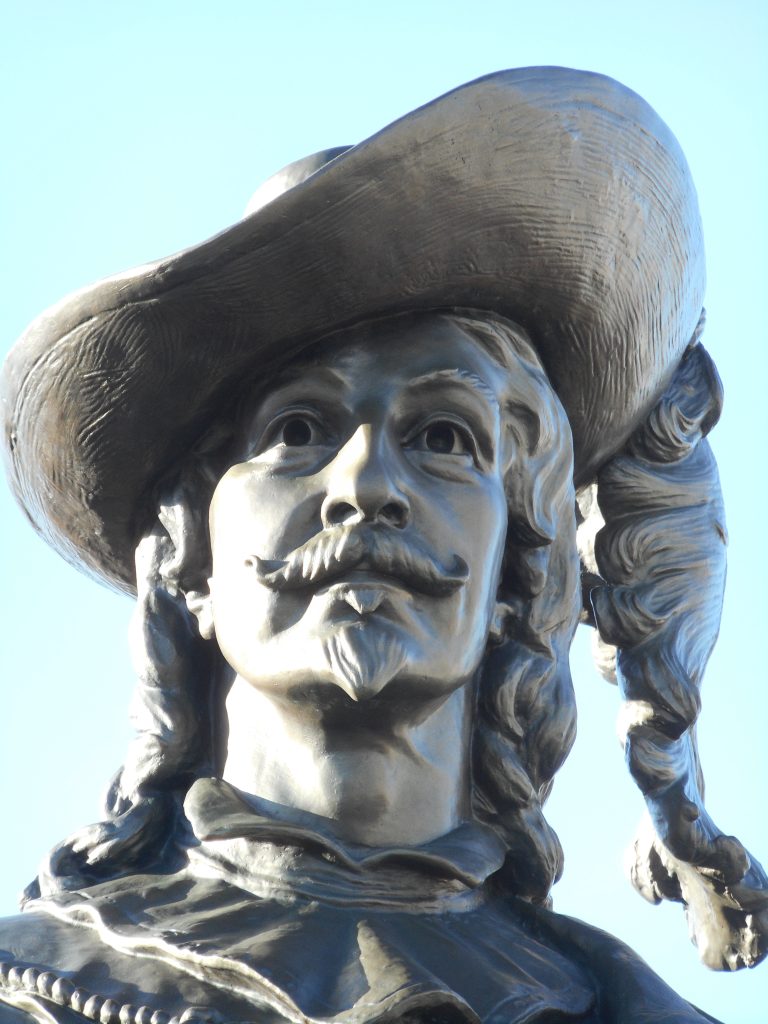 In 1604, he participated in another exploratory expedition – to Acadia, promising King Henry lV a report on further discoveries. The expedition was led by Pierre Du Gua De Monts, the Huguenot nobleman and merchant who had been given a 10-year fur trading monopoly by King Henry lV.
In 1604, he participated in another exploratory expedition – to Acadia, promising King Henry lV a report on further discoveries. The expedition was led by Pierre Du Gua De Monts, the Huguenot nobleman and merchant who had been given a 10-year fur trading monopoly by King Henry lV.
Champlain’s role this time was not just to observe and bring back a report but to actively participate in locating an ideal spot for the founding of a settlement. Two ships, the Bonne-Renommée and the Don-de-Dieu left for Acadia (NS, NB & PEI) with settlers and building materials to afford rapid construction of accommodations.
They first landed on the south coast of Nova Scotia (Port Mouton) from where they proceeded to investigate the Bay of Fundy including the St. John and St Croix Rivers. The St Croix River was chosen because it offered a wide deep mouth which they thought would provide year-round accessibility for European ships. They also thought that the coastline seemed fertile for raising crops.
However, they chose the island – St Croix– in the middle of the river for their first settlement because they thought of it as a naturally fortified location. Unfortunately, they did not take into consideration the difficulty of getting to the mainland because of ice on the river and the lack of access to fresh game.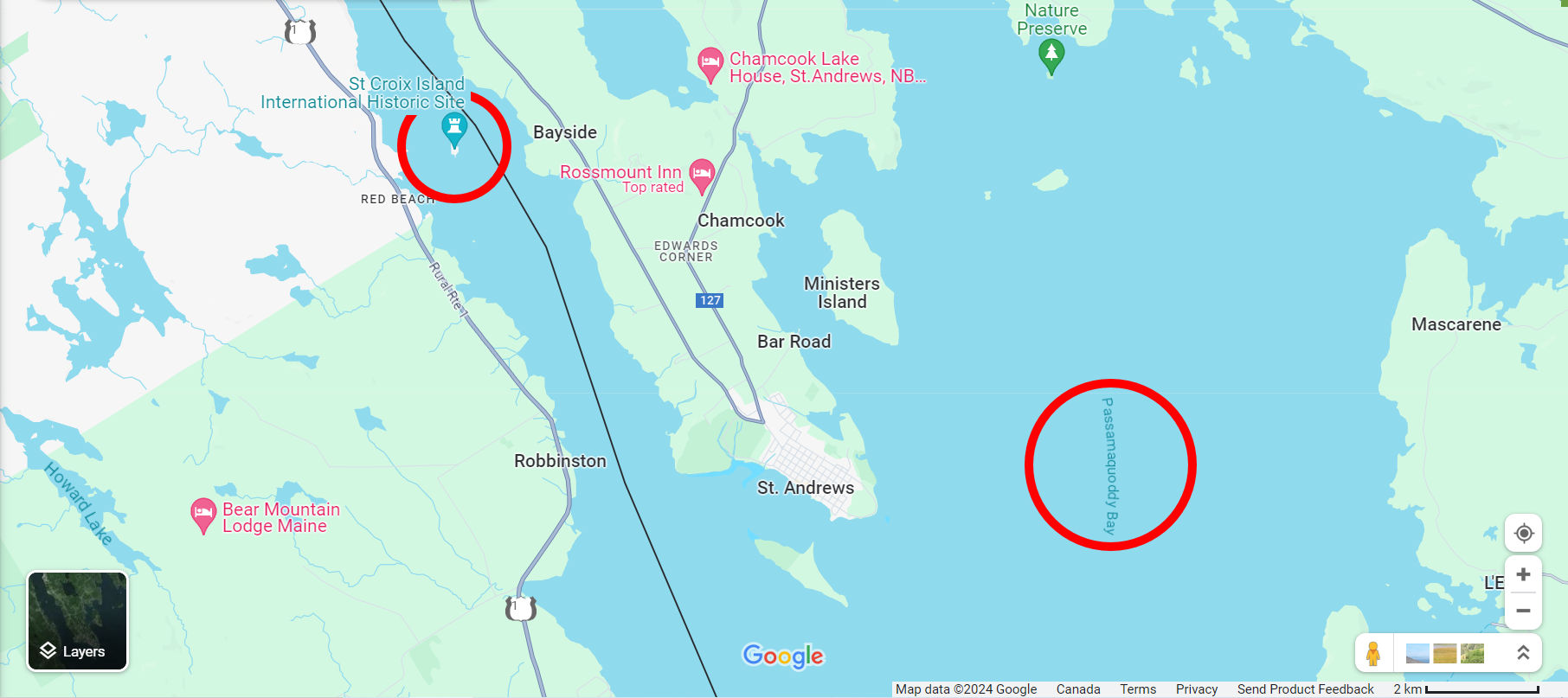
That winter, many men died of scurvy. In early Spring of 1605 they eventually moved the settlement to Port Royal ( Annapolis Royal) where new buildings were built and crops were planted so there was a full growing season. In 1604, because of the late arrival on St. Croix Island, not many crops thrived in preparation for the winter.
Francois Grave, who returned to France in the Fall of 1604, returned to Acadia in the Spring of 1605 bringing new settlers and fresh supplies. That was the protocol adopted while there were settlers in Acadia and New France. Ships would leave for France with a cargo of pelts in the Fall and return in the Spring with supplies for the colony.
Du Gua was called back to France in the Spring but did not leave until he had spent some time exploring the Atlantic Coast with Champlain. He returned to France in the Fall of 1605, leaving Francois Grave in charge of the colony. Jean de Biencourt de Poutrincourt was appointed as Lieutenant Governor of Acadia.
In the Spring of 1607 Du Gua’s monopoly was rescinded and all of the settlers commanded to return to France. Individual monopolies were no longer given by the King. Instead, the fur trade was open to all. The rights Du Gua held in Acadia were passed on to the Marquise de Guercheville. However, to compensate Du Gua for his losses, the monopoly was extended for another year in 1608.
Lynette is known as The Curious Canadian History Buff. She is passionate about discovering information about the Protestants who left indelible contributions on the pages of our Canadian History. She shares exactly what she has discovered by being curious. She does not see herself as having the last word on history. She encourages Christian readers to be ‘Bereans’ by doing their own research and not take her research as gospel. If you find new or different information, please share with her at: [email protected].
The Dark Ages & the French Wars of Religion Some time ago, I started to
In many places, like legislatures and schools, the Bible is considered ‘hate literature’. Counseling someone
Britain’s claim of Rupert’s Land by the Doctrine of Discovery, proved to be one of
Dominion Day had been a federal holiday that celebrated the enactment of The British North American Act which united four of Britain’s colonies – Nova Scotia, New Brunswick, Upper and Lower Canada (which became Ontario and Quebec), into a single country within the British Empire, and named that country The Dominion of Canada.